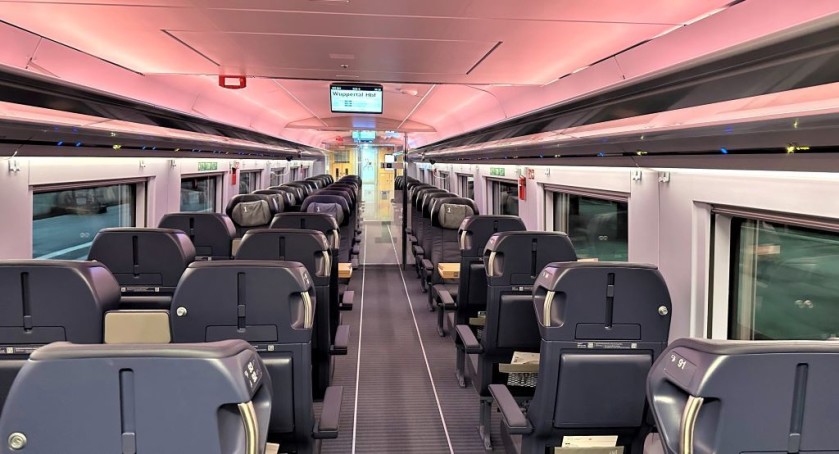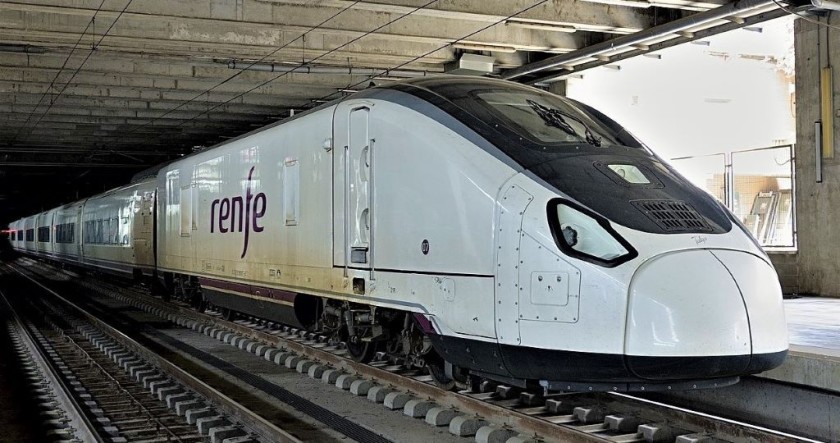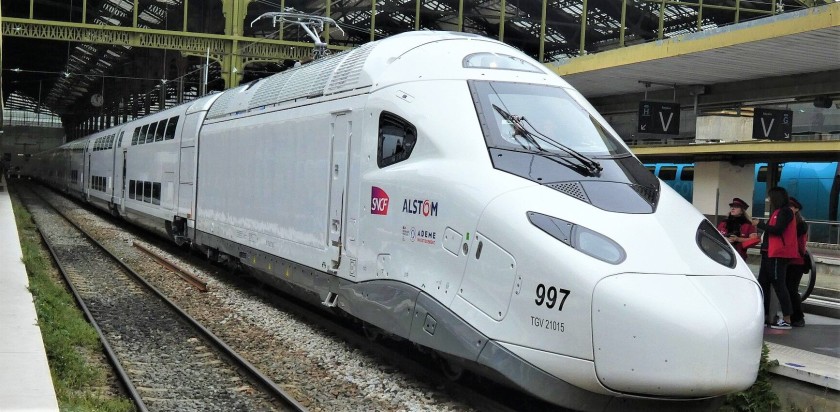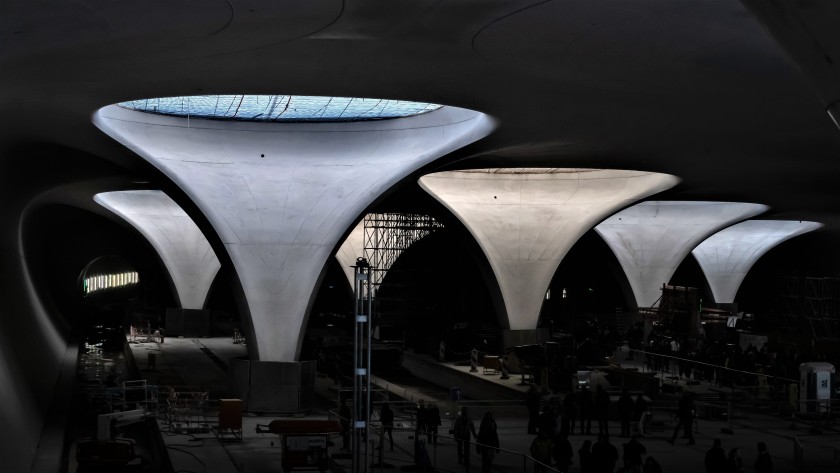Related Content
Content

Share
What can get overlooked, as people have surged back to Europe's railways, is that immense efforts are being made across the continent to ensure that this current Golden Age of European Rail Travel can continue to flourish.
And yes at times, for a small percentage of travellers, it may not have felt the way in the summer of 2023, but the overwhelming majority of disruptions are linked to future improvements.
Over the decade to come many European rail journeys will be faster and more frequent than ever before, on brand new trains providing new direct connections - by day and by night!
Yet more new high speed lines
Europe's plethora of high speed lines, have inevitably made a huge contribution to there never having been a better time to explore Europe by train.
They not only decrease journey times, they also lead to new journey opportunities.
Trains can continue on aptly 'classic' lines to distant destinations, which didn't previously have direct trains from the likes of Paris, Berlin and Madrid.
Over the next decade yet more high speed lines will transform many journeys for the better!
By 2033 rail journeys between London and the likes of Birmingham, Manchester and Glasgow will be transformed by the opening for service of HS2, but the new lines on continental Europe also have the scope to enhance many international journeys.
Brescia ↔ Padova
The contemporary Frecce trains on the Milano ↔ Venezia / Venice spend a blink and you'll miss it part of their journeys travelling at more than 250 km/h on a section of high speed line to the west of Brescia - but by the close of 2029 they will be maintaining this speed as far Padova / Padua.
As a consequence the Milano ↔ Venezia journey time will come down from 2hr 25min to around 1hr 40min.
Though travellers heading to and from Verona won't have to wait so long to experience the benefit, because trains will begin using the Brescia ↔ Verona section of the new line from 2026.
What is particularly tantalising about this new line is that the Frecce trains which will use it, won't solely be travelling between Milano and Venezia.
To the east they will travel to and from Torino, but it would be logical for at least one daily train in each direction to have its journey extended - thereby enabling Paris and Venezia to be linked by direct trains in a journey time of under nine hours.
Particularly as there are already direct Trenitalia trains between Paris and Milano - and the journey time will also come down by a further 25 - 30 minutes when the Mont Cenis Base Tunnel opens; see below.
In the west the journey time between Milano and Trieste will come down to around 3hr 45mins.
When the full Milano ↔ Venezia / Venice route opens it would also be logical for the current Milano ↔ Udine journeys by Frecce trains to be extended over the border to Villach in Austria.
If that did happen they could then connect in Villach with trains to/ from Graz, Ljubljana, Klagenfurt, Salzburg and Wien / Vienna.
Stuttgart ↔ Ulm
Something which went a tad under the radar when the European rail timetables last had a major update in December 2023, was that ICE trains began using the southern half of the new Stuttgart ↔ Ulm high speed line.
This was probably because only some existing services were switched to the new route, but from December 2025 the entire line should be opened to a range of rail services.
The journey time between Stuttgart and München / Munich will come down by around 30 minutes so that it will take under 1hr 30mins.
Though what's more exciting is that the new line is part of wider E.U. project to improve rail travel between Germany and Austria and beyond.
Therefore it's likely that many more trains will be operating between central Germany and Austria.
Travellers can probably look forward to direct ICE trains on a Köln / Cologne - Frankfurt Airport - München - Salzburg route and more Austrian Railjet trains between Stuttgart and Wien / Vienna via Salzburg.
Plus there will likely also be the possibility of travelling direct by Railjet trains between Frankfurt (Main) and Klagenfurt.
It's also likely that more of the existing high speed trains between Paris and Stuttgart will have their journeys extended to and from München / Munich.
Direct ICE trains between both Bruxelles and Amsterdam and München could also perhaps be taken off the wish-list and made a reality
Madrid ↔ Badajoz
At some time in 2024 high speed AVE trains will be travelling between Madrid and the city of Badajoz, thanks to the full opening of the western end of the Madrid—Extremadura high-speed rail line.
Until at least 2030 the trains will have to use classic tracks between Madrid and the town of Oropesa, because work on this section of the line has yet to begin.
But what's potentially more exciting than having 90 minutes shaved off the Madrid ↔ Badajoz journey time, is that the Spanish national rail operator will therefore have to use its special type of AVE trains - which are capable of switching between the high speed and 'classic lines'.
So these trains could also operate over the classic railway which links Badajoz and Portugal - and thereby eliminate the current second connection at Entroncamento, that's currently required on the Madrid ↔ Lisboa journey.
Meaning that direct Madrid ↔ Lisboa / Lisbon trains could and should return to the timetable within three years from now.
The Basque Y
The Basque Y project has proved to be one of those instances when a good idea, that was first suggested more than 20 years ago, has found itself up against political will and eye-wateringly expensive constriction costs in a mountainous area of Spain.
It is known as the Basque Y because trains will eventually be travelling up tp 3 x faster than current speeds on these routes:
- Burgos ↔ Bilbao
- Burgos ↔ San Sebastian - Donastia
- Bilbao ↔ San Sebastian - Donastia
However Latest estimates suggest that trains should begin to use the Burgos ↔ San Sebastian - Donastia section from 2027 / 2028.
As seen by SMTJ on a visit to San Sebastian, work is being undertaken to enable AVE trains to use the station, as part of a general rebuild project.
However, questions seemingly remain over the timing of the connection to /from Bilbao as the project seemingly lacks a central web source to provide information and updates.
AVE trains already use high speed lines between Madrid and Burgos, so on completion of the project another 45 mins will be shaved off journey times between Madrid and both Bilbao and San Sebastian - Donastia.
They're currently aren't any regular trains between Bilbao and San Sebastian - Donastia, so the journey time by rail between the two cities will could ultimately be reduced by around two hours!
Though what could be particularly fabulous is the potential for the further transformation of travel by train between France and Spain.
Both Spanish AVE and French TGV trains will be able to travel on a Paris - Bordeaux - Biarritz - Irun - San Sebastian-Donastia - Burgos - Madrid route.
The journey time will be around eight hours, similar to the time taken by the recently revived Madrid to Marseille service - so why not.
Other possibilities could include direct trains on journeys between Bilbao and both Bordeaux and Toulouse.
Improved international rail routes
New high speed lines inevitably have a wow factor, but across Europe there are huge engineering projects currently underway, which will will likely have an even more transformative impact on European rail routes than those new high speed lines.
Denmark ↔ Germany
Currently due to open in 2029 the Fehmarn Belt fixed link will transform travel by train between Scandinavia and Germany, because it will reduce the Copenhagen / København ↔ Hamburg journey time by around 50 minutes, bringing it down to under four hours.
One of the most successful rail innovations of recent years has been the introduction of overnight trains between Stockholm and both Berlin and Hamburg - which have been selling out months in advance for summer travel.
They will be switched to the new Fehmarn Belt route and the demand to travel by them could lead to an introduction of fresh journey opportunities.
It wouldn't be surprising if the night trains between Copenhagen / København and München / Munich, which were withdrawn back in 2016, were to come back.
Also direct day trains between Stockholm and Hamburg in a journey time of under of under eight hours would also be a possibility.
Journeys between Denmark and Germany won't need to be routed through Hamburg - and much has been made of the future rail link's top speed of 200 km/h.
So it's also likely that travellers will also be able to look forward to riding direct ICE trains between Copenhagen / København and both Berlin and Frankfurt (Main) - with these trains also calling in Hannover.
Mega tunnels in Austria
In recent years travelling by train between Switzerland and Italy has been transformed for the better by the opening of three 'base tunnels' under the Alps.
They have cut journey times on multiple routes by more than 30 minutes - and enabled the train service between the two countries to be more frequent than ever before.
During the next decade it will be Austria's turn to bask in this limelight, because trains will be begin to rush through three new mega tunnels:
- the Brenner Base Tunnel, currently scheduled to open in 2032;
- the Semmering Base Tunnel, currently scheduled to open in 2030;
- the Koralm Tunnel, due to be used by regular train services in 2025 / 2026.
The Koralm route will cut more than two hours from Graz ↔ Klagenfurt journeys.
Also from it's opening, the trains on the Wien / Vienna - Klagenfurt - Villach route will be switched to a Wien / Vienna - Graz - Klagenfurt - Villach route.
This will also save 20 minutes on the journey time by train between the Austrian capital and both Klagenfurt and Villach.
Two of the daily trains in each direction on the Wien / Vienna ↔ Villach route have their journeys extended to and from Venezia / Venice via Udine.
So by the close of 2026 Graz and Venezia will be connected by direct trains - and the journey time by the Railjet trains on the Wien / Vienna ↔ Venezia / Venice route will come down by 20 minutes.
Though this journey will be further transformed by the opening of the Semmering Base Tunnel, because it will take 30 minutes off the rail journey between Wien / Vienna and Graz.
Which will also reduce journey times beyond Graz to and from both Ljubljana and Venezia - so by 2030 the Wien ↔ Venezia journey by daytime train will come down to around 6hr 50 minutes.
Two years later, the Brenner Base Tunnel and its associated new railways will reduce the rail travel time between Innsbruck and Bolzano from two hours to only 50 minutes.
This route is taken by the EC trains between München / Munich and multiple cities in Italy including Bologna, Verona and Venezia / Venice.
By the time the Brenner Base Tunnel is completed, smart new Railjet trains will be operating these services - and it's also likely that Milano and Firenze / Florence will be added to the destinations list.
Also highly likely will be the extension of some of the Trenitalia's high speed Frecce trains on the Roma ↔ Bolzano route to and from Innsbruck.
Budapest ↔ Beograd
The railways of many countries in eastern Europe have contributed to current Golden Age of European Rail Travel.
Travelling by train in Poland and Hungary has been transformed in the past decade - and now it's Serbia which has embarked on the most radical overhaul of any European rail network.
New trains are already travelling at up to 200 km/h on an entirely reconstructed railway between the city of Novi Sad and the capital, Beograd/Belgrade.
By 2025 /2026 Novi Sad will be at the halfway point of a rebuilt railway route between the Hungarian and Serbian capitals.
The restored direct trains between Budapest and Beograd, which were withdrawn some years ago to enable the work to be carried out, are expected to have a journey time of around 2hr 45mins - half of what it was prevously.
The plan is that by 2029 the railway to the south of the Serbian capital, between Beogard and Nis, will also have been rebuilt, saving more than three hours on the previous journey time!
For international travellers what's significant about this is that three hours will also be saved on the currently unavailable Beograd - Sofia - Thessaloniki route.
The Budapest ↔ Sofia journey time by train could come down to around 9hr 30mins.
The world's longest rail tunnel
The only route currently taken by long-distance trains between France and Italy is the railway through the Mont Cenis Tunnel which straddles the border.
High speed TGV and Frecce trains on the Paris - Chambéry - Torino - Milano route travel this way, but they have to snake through Alpine passes to reach the tunnel, which makes riding the journey vulnerable to winter weather and rock falls.
Hence construction work has begun on what, at a length of 57.5 kilometres, will be the world's longest rail tunnel.
The current completion date on the Mont d'Ambin Base Tunnel is 2032, but what remains to be seen is whether it will be connected to a new Lyon ↔ Torino high speed line, or whether the current 'classic' line will be re-routed to meet the tunnel.
Though in itself the tunnel will reduce the Chambéry ↔ Torino journey time by around 25 minutes - and by the time it is opened, the Milano ↔ Venezia high speed could also be completed - which would enable Frecce trains to travel between Paris and Venezia / Venice in around 7hr 30mins.
If the Lyon ↔ Torino high speed line opens in full by 2033, that journey time will come down to approximately 6hr 45mins - and maybe the French and Italian capitals will also be linked by direct Paris ↔ Roma high speed trains.
The trains to come
The future improvements to European rail services, which will occur over the next decade, that will be most noticeable to a broad range of travellers, will be the swathe of brand new trains.
Three factors are driving this:
- the first generation of high speed trains have already been in service for more than 20 years;
- the coaches used on many non-high speed express, EC and IC trains have been in use since the 1990s
- the popularity of the new and revived overnight train services has led to a need for brand new sleeper and couchette coaches
new Nightjet trains
One of the many success stories of European rail travel in the past five years has been the growth of the Nightjet network, which is managed the Austrian national rail operator, OBB.
It has re-introduced overnight train services to a swathe of cities including Amsterdam, Paris and Bruxelles.
From December 2023 it won't be introducing some new sleeper coaches, instead it will be rolling out brand new entire trains!
The trains will be equipped with:
- free on-board Wi-Fi with free of charge access to the Railnet streaming portal,
- in cabin electronic travel information,
- in cabin charging stations for a wide range of electronic devices,
- new windows to enable better reception and a more stable connection for mobile phones,
- an electronic cabin access system,
- video surveillance in the train corridors.
double deck Railjets
Those new Nightjet trains will in effect be an overnight version of OBB's very smart Railjet trains, which it uses for its daytime express services.
With Austrian train travel attracting record numbers of travellers, OBB has now ordered double-decked version of its Railjets, which travellers should be able to experience from 2026.
new German long-distance trains

The coaches on the longer-distance IC express services operated by the German national rail operator DB were first rolled out back in the 1990s.
So by the end of 2025 they are to be replaced by the new ICE-L trains - which have been given that name, despite the fact that they won't be used on high speed services.
Though the routes which they will be used on include Amsterdam ↔ Berlin and Hamburg ↔ København / Copenhagen.
DB faced some criticism a few years ago when it introduced its ICE 4 trains, as they had a slower maximum speed than the previous generation of ICE 3 trains - but now the plan is to replace those ICE 3 trains on many routes with ICE 3neo trains, which will have a max speed of 320 km/h.
The routes which will experience the new trains include those from Frankfurt (Main) to both Amsterdam and Bruxelles.
The on board improvements over the previous generation of ICE 3 trains, include:
- bike racks,
- wheelchair accessible doors and power lifts,
- windows which will improve mobile device reception,
- power sockets at every seat.
- bigger luggage racks,
- adaptable lighting.
more AVE trains in Spain

High speed rail travel in Spain will take another leap forward from November when new Avril trains will begin to be introduced on routes between Madrid and north-west Spain.
Spain has a mix of railways, because the gaps between the rails on the purpose built high speed lines is narrower than on the 'classic' older lines.
What's exciting is that these new trains can switch between them - and on the 'classic' lines they will operate at a new highest ever speed!
Between now and 2025 their introduction should also enable the frequency of service on the routes between Madrid and north-west Spain to be increased significantly.
Image by FDV and downloaded from Wikimedia Commons.
the next generation of TGVs

From 2024 new double-decked TGV M trains will enter service.
They will initially appear on the Paris to Marseille route, but 15 of the trains which have been ordered will be able to operate internationally, so they will also be destined for the high speed route between France and Spain!
Compared to the iconic TGV Duplex trains, the TGV Ms will have:
- 20% more seats,
- flexible interiors which will enable easy conversion of the interiors between 1st and 2nd class,
- wheelchair accessible doors and power lifts,
- windows which will improve mobile device reception,
- more powerful WIFI.
- an enhanced bar area,
- adpatable lighting,
- social areas for friends and family groups.
Image taken by Rémi Simonnin and downloaded from Wikicommons.
The stations of tomorrow
The major stations of Europe are becoming ever easier to use thanks to the addition of escalators, elevators, new info systems and more better provision of traveller needs - from new luggage lockers to more shopping and food/drink outlets.
Locations including Basel SBB, Birmingham New Street, Edinburgh Waverley, London King's Cross, Milano Centrale, Rennes and Wien Hbf already offer better than ever traveller experiences.
By 2030 the likes of Amsterdam Centraal, Lyon Part-Dieu, Munchen HBf and Paris Gare du Nord will also have been regenerated.
However, construction works at the three stations listed below will not only make them easier to use - they will also transform the train services and routes which will use them!
Firenze Belfiore
The high speed Frecce trains on the Milan - Bologna - Florence - Rome route have to divert off the high speed route to call at Firenze S.M. Novella station - where they also have to reverse direction.
But from 2028 the plan is to use a new high-speed by pass so that this diversion off the direct route can be avoided.
It will enable the non-stop Milano ↔ Roma journey to be faster than ever before, because the entire route between the outskirts of the two cities will be on a high-speed line.
Though crucially for those travelling to and from Florence / Firenze, a brand new station will be opened on this new route under the city's streets.
Firenze Belfiore will enable the journey times by Frecce train to and from the city to be quicker - but the Milano to Roma fast trains which currently skip Florence / Firenze, will be able to serve the city and maintain their end-to-end journey times.
With the high speed trains passing through Firenze able to avoid S.M.Novella station, it will have the capacity for more terminating services - which could see the city linked by direct daytime trains to a swathe of destinations, such as Geneva, Munich, Paris, Vienna and Zurich!
Madrid Atocha
Long-established as one of Europe's most iconic transformations of a rail station, Madrid-Atocha has embarked upon a future expansion.
New lower-level platforms / tracks are being created, so that high-speed AVE trains using the Madrid interconnector can call at the station.
The 'interconnector is a new rail tunnel under the city, which links the high-speed railways to the north of the Spanish capital, to those which head east and south.
High speed AVE trains will then be able to call at Madrid Atocha when heading cross country on routes such as Gijon ↔ Valencia and Bilbao ↔ Sevilla,
By 2028 it will be theoretically possible to connect in San Sebastian-Donastia between high speed TGV trains to and from Paris - and high-speed AVE trains to and from destinations in the south of Spain, such as Malaga.
Stuttgart Hbf

High speed rail lines can require the construction of new stations, but they tend to be located in the open spaces, close to the city which the line is passing by.
However, in Stuttgart an eight track station is being built under the the city's existing main railway terminus.
It will be at the northern end of the new Stuttgart ↔ Ulm high speed railway and will transform the access to and from the city by ICE and other trains.
Long-distance trains passing through the city currently have to reverse direction at Stuttgart Hbf - but when the huge extension to the station opens it doors in 2025, they will no longer do so.
The ease of which trains will be able to call at Stuttgart, along with the new high speed line, will transform the route between Mannheim and Munich.
As a result more trains will call at Stuttgart, enhancing it's role as a key hub location of international European rail travel.
The station will have more trains to and from multiple cities including Berlin, Cologne, Salzburg and Vienna - as well as its existing connections by day and night trains to and from Budapest, Innsbruck, Paris, Venice, Zagreb and Zurich
By 2027 its departure screens could also be listings trains arriving and departing to and from the likes of Amsterdam, Basel, Bruxelles and Milano.
Image taken by Pjt56 and downloaded from Wikicommons.

Simon Harper
I wanted to share my passion for train travel and explain how anyone can take the fantastic journeys I have taken.

This is one of more than 100 train travel guides available on ShowMeTheJourney, which will make it easier to take the train journeys you want or need to make. As always, all images were captured on trips taken by ShowMeTheJourney.
This second version of ShowMeTheJourney is exciting and new, so we are genuinely thrilled that you are here and reading this, but we also need your help.
We’re striving not to let anything get in the way of providing the most useful service possible, hence a facility has been set up with DonorBox which can be used to support the running costs and make improvements.
Instead of advertising or paywalls, your financial support will make a positive difference to delivering an enhanced service, as there’s a lot of ideas which we want to make happen.
So if you have found the info provided here to be useful, please consider saying thank you.


